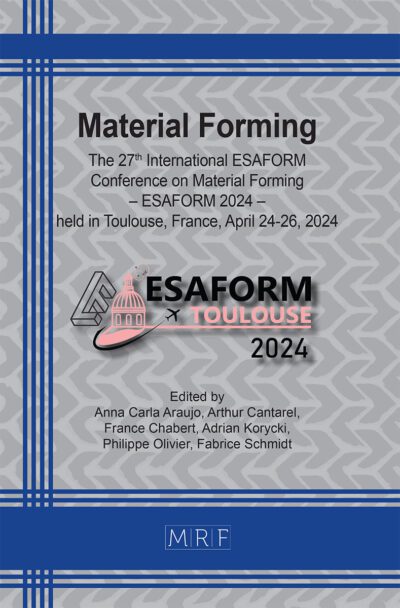Simulation of the joining process of graded hardened multi-range capable rivets
Pia K. Holtkamp, Christian R. Bielak, Mathias Bobbert, Gerson Meschut
Abstract. The versatile self-pierce riveting (V-SPR) is a further development of semi-tubular self-pierce riveting. V-SPR enables adaptation to changing boundary conditions, such as a change in the material thickness combination, without varying the rivet die combination due to increased punch actuation and the use of multi-range capable rivets [1]. The inner punch first sets the rivet. The outer punch then forms the rivet head to the respective sheet thickness. For this, the rivet requires a hard shank and a ductile rivet head, which is achieved by an inductive local hardening process [2]. Until now, the joint formation of rivets with graded hardness profile has been challenging to estimate in the FEM simulation due to the inhomogeneous material conditions in the rivet. In this study, a method capable of reproducing the experimentally determined hardness levels of rivets in detail is shown. This FE model enables the realistic modelling of the mechanical properties of the rivet on the basis of the hardness profile in order to predict the correct deformation processes and stresses during the riveting process. First, the detailed experimental hardness mapping of the locally heat-treated rivets is transferred into the FE model. The FEM material model can predict the local strength of the rivet based on hardness by scaling the flow curves. To estimate the predictive capability of the FEM model, the joint formation of rivets with different graded hardness profiles is compared experimentally and simulative. Based on the validated model, the influence of different rivet hardness profiles on the joint formation is analysed numerically. By adapting the material model, a high level of correlation between the experiment’s joint formation and the simulation can be achieved.
Keywords
Self-Piercing Riveting, Versatile Joining, FEM, Heat Treatment
Published online 5/7/2025, 9 pages
Copyright © 2025 by the author(s)
Published under license by Materials Research Forum LLC., Millersville PA, USA
Citation: Pia K. Holtkamp, Christian R. Bielak, Mathias Bobbert, Gerson Meschut, Simulation of the joining process of graded hardened multi-range capable rivets, Materials Research Proceedings, Vol. 54, pp 1413-1421, 2025
DOI: https://doi.org/10.21741/9781644903599-153
The article was published as article 153 of the book Material Forming
![]() Content from this work may be used under the terms of the Creative Commons Attribution 3.0 license. Any further distribution of this work must maintain attribution to the author(s) and the title of the work, journal citation and DOI.
Content from this work may be used under the terms of the Creative Commons Attribution 3.0 license. Any further distribution of this work must maintain attribution to the author(s) and the title of the work, journal citation and DOI.
References
[1] F. Kappe, S. Wituschek, M. Bobbert, and G. Meschut, “Determining the properties of multi-range semi-tubular self-piercing riveted joints,” Prod. Eng. Res. Devel., vol. 16, 2-3, pp. 363–378, 2022. https://doi.org/ 10.1007/s11740-022-01105-2
[2] F. Kappe, M. Bobbert, and G. Meschut, “Influence of local heat treatment of rivets on the joint formation of a versatile joining process,” IOP Conf. Ser.: Mater. Sci. Eng., vol. 1307, no. 1, p. 12009, 2024. https://doi.org/ 10.1088/1757-899X/1307/1/012009
[3] European Commission. “Delivering the European Green Deal.” [Online]. Available: https://commission.europa.eu/strategy-and-policy/priorities-2019-2024/european-green-deal/delivering-european-green-deal_en
[4] K. Martinsen, S. J. Hu, and B. E. Carlson, “Joining of dissimilar materials,” CIRP Annals, vol. 64, no. 2, pp. 679–699, 2015. https://doi.org/ 10.1016/j.cirp.2015.05.006
[5] Technical Bulletin DVS 3410: Self-pierce Riveting – Overview., European Research Association for Sheet Metal Working, Düsseldorf, 2019.
[6] Donhauser G, Mauermann R, Quaißer G et al, “Stamping rivet upsetting tool comprises die endface which is radially divided into sectors outside raised area,” DE19847980 A1.
[7] W. G. Drossel and M. Jäckel, “New Die Concept for Self-Pierce Riveting Materials with Limited Ductility,” KEM, vol. 611-612, pp. 1452–1459, 2014. https://doi.org/ 10.4028/www.scientific.net/KEM.611-612.1452
[8] F. Kappe, S. Wituschek, M. Bobbert, M. Lechner, and G. Meschut, “Joining of multi-material structures using a versatile self-piercing riveting process,” Prod. Eng. Res. Devel., vol. 17, no. 1, pp. 65–79, 2023. https://doi.org/ 10.1007/s11740-022-01151-w
[9] B. Uhe, G. Meschut, and M. Merklein, “Ressourcenschonende Herstellung von Halbhohlstanznieten durch Prozesskettenverkürzung,” Dissertation, Shaker Verlag.
[10] C.-M. Kuball, “Grundlegende Untersuchungen zur umformtechnischen Herstellung von Halbhohlstanznieten aus hochverfestigenden Werkstoffen,” 2024. https://doi.org/ 10.25593/978-3-96147-718-0.
[11] M. Costas, D. Morin, J. K. Sønstabø, and M. Langseth, “On the effect of pilot holes on the mechanical behaviour of flow-drill screw joints. Experimental tests and mesoscale numerical simulations,” Journal of Materials Processing Technology, vol. 294, p. 117133, 2021. https://doi.org/ 10.1016/j.jmatprotec.2021.117133
[12] Saarstahl. “Werkstoff-Datenblatt Saarstahl C35R.” Accessed: Feb. 12, 2024. [Online]. Available: https://www.saarstahl.com/sag/downloads/download/9082
[13] Novelis Global Automotive, Datasheet: Novelis AdvanzTM 6F – e170.
[14] Salzgitter Flachstahl GmbH. “Datenblatt: CR330Y590T-DP (HCT590X+Z*, HCT600XD, HC340XD**) CR330Y590T-DP (HCT590X+Z*, HCT600XD, HC340XD**): Mehrphasenstähle zum Kaltumformen – Dualphasenstähle.” Accessed: Nov. 28, 2023. [Online]. Available: https://www.salzgitter-flachstahl.de/fileadmin/mediadb/szfg/informationsmaterial/produktinformationen/kaltgewalztes_feinblech/deu/hct590x.pdf
[15] P. Holtkamp, F. Kappe, P. Probst, M. Bobbert, and G. Meschut, “Investigation of local heat treatment strategies for a multi-range capable rivet and the influence on joint formation and load-bearing capacity,” Proceedings of the Institution of Mechanical Engineers, Part L: Journal of Materials: Design and Applications, 2025, Art. no. 14644207241307508. https://doi.org/ 10.1177/14644207241307508
[16] Prüfung metallischer Werkstoffe: Druckversuch bei Raumtemperatur, 50106, DIN Deutsches Institut für Normung e. V, Berlin, Feb. 2023.
[17] F. Kappe, M. Bobbert, and G. Meschut, “New Approach for Versatile Self Piercing Riveting: Joining System and Auxiliary Part,” KEM, vol. 883, pp. 3–10, 2021. https://doi.org/ 10.4028/www.scientific.net/KEM.883.3
[18] N. Karathanasopoulos and D. Mohr, “Strength and Failure of Self-Piercing Riveted Aluminum and Steel Sheet Joints: Multi-axial Experiments and Modeling,” Journal of Advanced Joining Processes, vol. 5, p. 100107, 2022. https://doi.org/ 10.1016/j.jajp.2022.100107
[19] F. Kappe, C. Zirngibl, B. Schleich, M. Bobbert, S. Wartzack, and G. Meschut, “Determining the influence of different process parameters on the versatile self-piercing riveting process using numerical methods,” Journal of Manufacturing Processes, vol. 84, pp. 1438–1448, 2022. https://doi.org/ 10.1016/j.jmapro.2022.11.019
[20] G. Meschut, O. Hahn, S. Horstmann, A. Esderts, and M. Sander, “Betriebsfestigkeit stanzgenieteter Bauteile: Ergebnisse eines Vorhabens der industriellen Gemeinschaftsforschung (IGF),” EFB-Forschungsbericht 429. Hannover: Europäische Forschungsgesellschaft für Blechverarbeitung e.V, 2016.













